Potato: Insect, Mite and Nematode Pests Management
Potato: Insect, Mite and Nematode Pests Management
Aphid
Biology:- Aphids reproduce in two ways: by laying eggs and giving birth to young ones. Which birth process is used depends on environmental conditions and the availability of food.
- When food is plentiful, aphids give birth to live young. Populations develop quickly as this pest has many young ones, a short lifespan and pre-adult insects can also give birth.
- Eggs hatch after three or four days. Young aphids, called nymphs, need five to eight days to become adults
- Direct damage: Aphids damage plants by puncturing them and sucking their juices. They damage the young and soft parts of plants, such as new leaves and shoots. Signs of damage are leaves not opening properly and being smaller in size. Severe infestation can cause shoots to wilt and dry out.
- Indirect damage: Aphids have wings and can move from plant to plant spreading viral diseases, picked up from infected plants. Aphids secrete a sugary liquid that stimulates black sooty mold growth. It can cover the surface of leaves which affects the way they absorb sunlight.
- A relative humidity of 66 + 2.8% and 11 – 140C temperature are ideal for development of this aphid.
- Its population sharply decreases with increase in RH over 73 percent.
- Parasitoids: Lysiphlebus sp, Diaeretiella sp., Aphelinus sp., Aphidius colemani etc.
- Predators: Ladybird beetle, lacewing, spider, hover fly etc.
Leaf miner
Biology:It was introduced into India through Chrysanthemum cuttings.
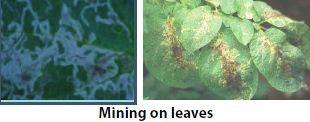 Egg: Eggs are laid inside leaves, they are very small and clear in color. Larvae hatch after about 2 - 3 days.
Egg: Eggs are laid inside leaves, they are very small and clear in color. Larvae hatch after about 2 - 3 days.- Larva: Larvae remain inside leaves. They are very small and have no legs so cannot move from one leaf to another. The larval stage lasts around 6-12 days. Full grown larvae measure 3 mm.
- Pupa: These are formed in the ground or inside leaves. On potato plants, pupae usually fall to the ground. The pupal stage lasts around 14-16 days. Pupation takes place inside a thin loose mesh of silken cocoon.
- Adult: These are extremely small at 2-4 mm in length, black in color with two yellow spots on their backs, measuring 1.5 mm in length. They are most active in the morning from 7:00 to 9:00 and in the afternoon from 16:00 to 18:00. Adult flies produce an average of 166 eggs per female. They are attracted to the color yellow. The female fly punctures upper surface of leaf to lay eggs singly. The egg hatches in 4 days. Total life cycle takes 3 weeks. Generally it does not cause economic damage.
- The leaf miner flies damage plants during its larval and adult stages mainly on the lower third of plants.
- Larvae begin eating the insides of leaves immediately after hatching, and bore mines inside them.
- In instances of severe infestation, all that is left of leaves is their upper and lower skins.
- Affected leaves become dry and drop off the plant.
- Adult flies puncture holes in leaves in order to lay eggs and feed on plant juices.
- Parasitoids: Chrysocharis pentheus , Gronotoma micromorpha, Diglyphus isaea etc.
- Predators: Lacewing, ladybird beetle, spider, red ant etc.
Whitefly
Biology:- Egg: The female whiteflies lay eggs singly on the underside of the leaves. Eggs are smooth, sub elliptical, stalked, and broader at basal end. Its colour is light yellow, when freshly laid, turn dark brown later on. The eggs hatch in 5-17 days. Stalked nymph: It is louse like, sluggish creature having pale-yellow body. The nymphal stage lasts 14 to 81 days.
- Pupa: Convex in shape and possesses deep yellow patches on the abdomen.
- Adult: In 2-8 days, the pupae change into white flies. Adult fly is small winged insect having light yellow body of 1.0-1.5 mm length dusted with a white waxy powder. Wings are pure white and have prominent long legs. The life cycle is completed in 14-122 days. Eleven generations of this pest are completed in a year.
- Chlorotic spots
- Yellowing
- Downward curling and drying of leaves.
- Vector of potato leaf curl disease
- The temperature of 28-36 0C and 62-92% relative humidity and scanty rainfall during August to January are quite favorable for this pest.
- Parasitoid: Encarsia formosa, Eretmocerus spp. etc.
- Predators: Ladybird beetle, lacewing, spider, hover fly, reduviid bug, robber fly etc.
Spider mites
Biology:- Egg: Eggs are hyaline, globular laid in mass
- Nymph: Yellowish in colour
- Adult: Red coloured small size
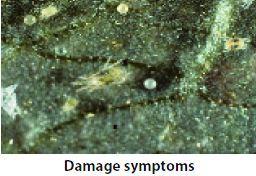 Affected leaves become reddish brown and bronzy
Affected leaves become reddish brown and bronzy- Under severe infestation larvae construct silken webbing on the leaves
- Leaves wither and dry
- Flower and fruit formation affected
- Predators: Predatory mites, predatory thrips, Oligota spp., Orius spp., anthocorid bugs, hover flies, mired bug etc.
Thrips
Biology: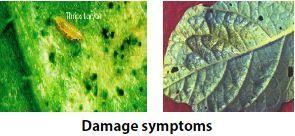 Thrips are very small, have elongated abdomens and are yellowish or blackish in color. Although the adults have wings, these insect pests do not usually fly. They are often found on potato plants throughout all growth stages, from sprout development to tuber maturation. Thrips reproduce by laying eggs. Nymphs emerge from the eggs. It takes between 7 and 12 days to develop from eggs into adult thrips.
Thrips are very small, have elongated abdomens and are yellowish or blackish in color. Although the adults have wings, these insect pests do not usually fly. They are often found on potato plants throughout all growth stages, from sprout development to tuber maturation. Thrips reproduce by laying eggs. Nymphs emerge from the eggs. It takes between 7 and 12 days to develop from eggs into adult thrips.
As with aphids, thrips also cause direct and indirect damage:
- Direct damage: Thrips damage the undersides of leaves by sucking their juices. They damage young and soft parts of plants such as new leaves and shoots. As a result, leaves curl downwards and change to a blackish silver color. Severe infestation causes young leaves to wilt and dry out.
- Indirect damage: Thrips can carry and spread viral diseases.
- Parasitoids: Ceranisus menes
- Predators: Predatory thrips, minute piratebug, lacewing etc.
Jassid / leaf hopper
Biology: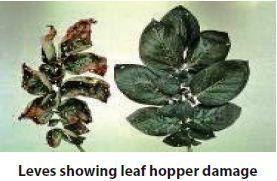 Egg: Elongated yellow-white eggs are deposited in leaf vein. It becomes greyish yellow before hatching. The female jassids lay about 15 eggs on the underside of leaves embedding them into leaf veins. The eggs hatch in 4-11 days.
Egg: Elongated yellow-white eggs are deposited in leaf vein. It becomes greyish yellow before hatching. The female jassids lay about 15 eggs on the underside of leaves embedding them into leaf veins. The eggs hatch in 4-11 days.- Nymph: Nymphs are pale – green, wedge shaped and their wing pads extend up to the fifth abdominal segment. The nymphal stage is complete in 7-21 days.
- Adult: It is a wedge shaped and pale green insect of about 3.5 to 5mm length having a black spot on each transparent forewing. It turns reddish brown during winter. Winged adults live for 35-50 days. This pest completes seven generations in a year.
- Both nymphs and adults of Jassids suck plant sap as a result of their severe attack, the leaves curl; turn pale, bronze and dry up.
- Temperature 27 to 360 C and relative humidity below 75% favors the multiplication of Jassid.
- Parasitoids: Anagrus flaveolus, Stethynium triclavatum etc.
- Predators: Lacewing, red ant, mirid bug, big-eyed bug, ladybird beetle etc.
Potato tuber moth
Biology: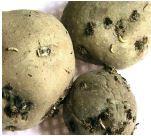 Eggs: The eggs are oval and measure less than 1mm in diameter. The female moth lays eggs on the underside of leaves or on exposed tubers near the eye. Each female can lay 150-200 eggs. Incubation period is 3-7 days.
Eggs: The eggs are oval and measure less than 1mm in diameter. The female moth lays eggs on the underside of leaves or on exposed tubers near the eye. Each female can lay 150-200 eggs. Incubation period is 3-7 days.- Larva: Newly emerged larvae are gray, yellowish white with brown head. Larval period is 15-20 days.
- Pupa: Full grown caterpillars come out of the tubers/ foliage and pupate in silken cocoons either in dried leaves, soils, over the stored tubers or in cracks and crevices in the store. Pupal period lasts for 11-12 days.
- Adult: It is a small grayish brown moth. Total life cycle is completed in 20-30 days at optimum conditions of 22-280C temperature and 60-70% relative humidity. There are 8-9 overlapping generations in a year.
- Potato tuber moths affect both tubers and foliage.
- Larvae eat their way inside tubers either in the field or the storage area.
- Severe infestation generally occurs in storage causing irregular galleries and 'tunnels' deep inside the tube.
- Larvae feces can be seen near bore holes.
- On foliage, larvae attack the stems and leaves of potato plants.
- They enter leaves, eat the inside and leave only a dried up outer skin.
- Severe infestation occurs in same areas, but yield loss is generally limited.
- Parasitoids: Chelonus blackburni, Copidosoma koehleri, Trichogramma spp., Apanteles sp., Pristomerus vulnerator etc.
- Predators: Lacewing, red ant, ladybird beetle, spider, robber fly, dragonfly etc.
Potato cutworm
Biology:Cutworms damage potato plants, and affect almost all types of plants including weeds. Cutworms reproduce by laying eggs. Their life cycle includes eggs, larvae, pupae and moths. It takes up to 36 days for them to develop from eggs to adult insects. The various stages display the following characteristics:
- Egg: Eggs are creamy white, dome-shaped laid on the surface of the soil, but are very difficult to see. Each female moths come out at dusk and lay eggs (200-350) in clusters of about 30 each, either on the under surface of the leaves of host plants or in the soil.

- Larva: Newly emerged young larva is yellow or blackish- green in colour, 1.5 mm long with a shiny, black head and a black shield on the prothorax. The full-grown larva is about 42-45 mm long and is dark or dark brown with a plump and greasy body and lives in the soil. They have striped markings running down the sides of their bodies. The larval stage varies from 30-34 days,
- Pupa: Pupae are brown to dark brown, about 1.5 to 2.0 cm in length and are usually found in or on piles of leaf mould. Pupation takes place underground in an earthen chamber is completed in 10 to 30 days
- Adult: It measures about 25 mm from the head to the tip of the abdomen and looks dark with some grayish patches on the back and dark streaks on the forewings. Adults live for 7-10 days. The moths usually emerge at night. The life cycle is completed in 48 to 77 days. This pest generally completes three generations in a year.
- These pests damage plants and tubers during dark.
- They attack young plants by severing their stems, pulling all parts of the plant into the ground and devouring them.
- Plants with severed stems have difficulty growing again.
- This pest can cause serious damage; particularly when crops are at 25 – 35 days after planting. Signs of damage on tubers are boreholes larger than those made by potato tuber moths.
- Persistent dry weather with lesser or no rainfall, reduced humidity & 16 - 23 OC temperature favor the development of cutworm
- Parasitoids: Trichogramma spp., Tetrastichus spp., Telenomus spp., Bracon spp., Campoletis spp., Chelonus spp., Ichneumon spp., Carcelia spp. etc.
- Predators: Lacewing, ladybird beetle, spider, red ant, dragonfly, robber fly, reduviid bug, praying mantis, King crow etc.
Tobacco caterpillar
Biology:It is found throughout the tropical and sub-tropical parts of the world, wide spread in India. Besides tobacco, it feeds on cotton, castor, groundnut, tomato, cabbage and various other cruciferous crops.
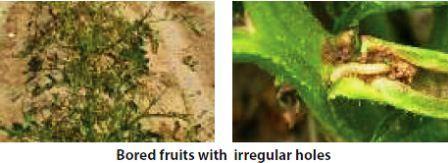 Egg: Female lays about 300 eggs in clusters. The eggs are covered over by brown hairs and they hatch in about 3-5 days.
Egg: Female lays about 300 eggs in clusters. The eggs are covered over by brown hairs and they hatch in about 3-5 days.- Larva: Caterpillar measures 35-40 mm in length, when full grown. It is velvety, black with yellowish – green dorsal stripes and lateral white bands with incomplete ring – like dark band on anterior and posterior end of the body. It passes through 6 instars. Larval stage lasts 15-30 days
- Pupa: Pupation takes place inside the soil. Pupal stage lasts 7-15 days.
- Adult: Moth is medium sized and stout bodied with forewings pale grey to dark brown in colour having wavy white crisscross markings. Hind wings are whitish with brown patches along the margin of wing. Pest breeds throughout the year. Moths are active at night. Adults live for 7-10 days. Total life cycle takes 32-60 days. There are eight generations in a year.
- In early stages, the caterpillars are gregarious and scrape the chlorophyll content of leaf lamina giving it a papery white appearance.
- Later they become voracious feeders making irregular holes on the leaves.
- Irregular holes on leaves initially and later skeletonization leaving only veins and petioles
- Heavy defoliation.
- Maximum S. litura built up at temperature ranges from 26 to 35.1°C, relative humidity ranges from 89 and 62%, zero rainfall, total sunshine hours (64.6 hrs/week).
- S. litura population showes a positive correlation with relative humidity, sunshine hours, whereas negatively correlated with wind velocity.
- Parasitoids: Trichogramma sp., Tetrastichus spp., Telenomus spp., Bracon spp., Campoletis spp., Chelonus spp., Ichneumon spp., Carcelia spp etc.
- Predators: Lacewing, ladybird beetle, spider, red ant, dragon fly, robber fly, reduviid bug, praying mantis, King crow etc.
Leaf eating caterpillar / gram pod borer
Biology:- Egg: The spherical, yellowish eggs are laid singly on tender parts and buds of plants. The egg period lasts for 2-4 days.
- Larva: Caterpillars vary in colour, initially brown and later turn greenish with darker broken lines along the side of the body. The larval period lasts for 18-25 days. Body covered with radiating hairs. When full grown, they measure 3.7 to 5 cm in length. The full grown caterpillar pupates in the soil in an earthen cell and emerges in 16-21 days.
- Pupa: Pupation takes place inside the soil. Pupal stage lasts 7-15 days.
- Adult: Moth is stout, medium sized with brownish/grayish forewings with a dark cross band near outer margin and dark spots near costal margins, with a wing expense of 3.7cm.
- Young larva feeds on the leaves.
- Feed on leaves, shoots and buds
- Parasitoids: Trichogramma spp., Tetrastichus spp., Telenomus spp., Bracon spp., Campoletis spp. Chelonus spp., Ichneumon spp., Carcelia spp. etc.
- Predators: Lacewing, ladybird beetle, spider, red ant, dragonfly, robber fly, reduviid bug, praying mantis, King crow etc.
White grub / root grub
Biology:White grubs are the larval form of beetles. The length of the life cycle varies from 1–4 years, depending on the species.
- Egg: This insect develops by laying eggs. Females lay 50–100 eggs individually or in groups in small cells composed of soil particles glued together with a sticky substance secreted by the beetle. Eggs hatch in 1 to several weeks, and grubs feed on roots of plants until cold weather when they move down 10– 12 inches below the soil surface to spend the winter.
- Larva: They are large reaching 2-3 cm in length, are shaped like the letter C, and have three pairs of legs on their thorax. Their heads are hard and ruddy-brown in color, and they have strong mandibles. White grubs develop for up to seven months.
- Pupa: After 7 months the larva have a rest period of 40 days after which they pupate and remain in that form for two months.
- Adult: Pupa over winter deep in the soil for five to 10 months and become active again as the ground warms up in the spring then they pupate and transform into adults.

- The grubs initially feed on rootlets/roots and then on tubers.
- The first stage grubs feed on live roots while the second and third instar grubs make large, shallow and circular holes in the tuber
- Tubers damaged by white grubs have irregular holes. More than two holes are often found in one tuber. These holes are not so deep, as white grubs do not enter and live.
Root-knot nematode & cyst nematode
Cyst nematode:- One life cycle of the golden cyst nematode is completed with each crop.
- Between crops, eggs survive within cysts in the soil. When a potato plant is growing, substances exuded by the roots stimulate the eggs to hatch.
- Each egg contains a second-stage juvenile which hatches, moves from the cyst into the soil and penetrates a host root just behind the root-tip.
- The juvenile establishes a permanent feeding site in the root and develops to become an adult. Adult stage, males leave the root and move through the soil to find females.
- Females remain in the root, expanding and eventually rupturing it, remaining attached by the head and neck only.
- After fertilization, the female produces 300 to 500 eggs which it retains within her body. The female dies with the root, but her skin hardens and turns brown while forming a protective cyst for the eggs.

- Swelling of roots – Nematodes damage and live in the roots of potato plants, causing them to swell. Swollen roots cannot function normally and affect growth of the plant above them. In hot conditions, plants damaged by nematodes will show wilting.
- Irregular tuber shape – Tubers change shape and lumps appear on their surfaces. Heavily infested plants are stunted and exhibit early maturity. Reduction in size and number of tubers reduces the yield and warty 'pimple-like' outgrowths formed on tubers result in qualitative reduction.
- Small patches of poorly growing plants appear in the field. Such plants show temporary wilting, stunting and premature yellowing symptoms. The size and number of tuber is reduced. Small mustard seed size yellow or white female nematodes are seen sticking to the roots.
- Primary: Cysts and egg masses in infected plant debris and soil or collateral and other hosts like Solonaceous, Malvaceous and Leguminaceous plants act as sources of inoculum
- Secondary: Autonomous second stage juveniles that may also be water dispersed
IPM for Potato
To know the IPM practices for Potato, click here.
Source: NIPHM, and Directorate of Plant Protection, Quarantine & Storage
Last Modified : 10/11/2024
This topic covers the information related to Nutri...
This topic covers the Information related to Disea...
This topic provides information about use of nano ...
This topic covers the Information related to Crop ...
